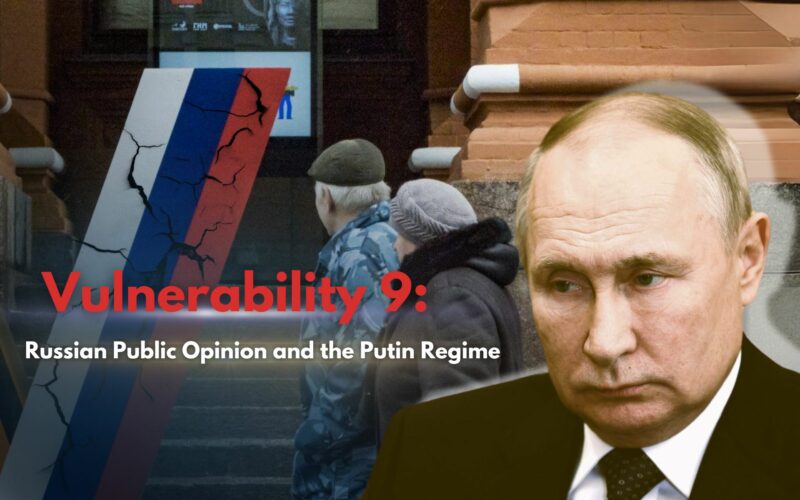10 essays analyzing the strengths and weaknesses of the Russian Federation were released by the Center for New American Security (CNAS): “Identifying Russian Vulnerabilities and How to Leverage Them”
INTRODUCTION: Top Russian weakness that West can exploit: Russian Public Opinion and the Putin Regime RUSSIA’S DEFENSE INDUSTRY VULNERABILITY : Top Russian weakness that West can exploit: Russian Public Opinion and the Putin Regime RUSSIAN ARMS SALES: Top Russian weakness that West can exploit: Russian Public Opinion and the Putin Regime RUSSIA’S TECHNOLOGY AND CYBER INDUSTRIES: Top Russian weakness that West can exploit: Russian Public Opinion and the Putin Regime RUSSIA’S FINANCIAL SECTOR: Top Russian weakness that West can exploit: Russian Public Opinion and the Putin Regime RUSSIA’S RELIANCE ON OIL AND GAS: Top Russian weakness that West can exploit: Russian Public Opinion and the Putin Regime UKRAINE AS RUSSIA’S SOFT UNDERBELLY: Top Russian weakness that West can exploit: Russian Public Opinion and the Putin Regime RUSSIA’S DECLINING INFLUENCE IN CA AND THE SOUTH CAUCASUS: Top Russian weakness that West can exploit: Russian Public Opinion and the Putin Regime Russia’s Crumbling Diplomacy: Top Russian weakness that West can exploit: Russian Public Opinion and the Putin RegimeVulnerability 9: Russian Public Opinion and the Putin Regime
Russia’s war in Ukraine creates new domestic challenges for Putin and his longtime ability to maintain high levels of public support. Autocrats who lose popular support not only find it harder to govern, but they are also at greater risk of mass protest or an elite coup.
By Timothy Frye
The Vulnerability of Russian owner of the Kremlin Vladimir Putin realizes that it is easier to rule as a popular than an unpopular autocrat. Like all autocrats, he faces the dual threats of a coup by elites and a revolt by the mass public, and it is difficult to address both problems at once. For example, state resources spent on social policy to placate the public cannot be directed to elite cronies and vice versa. Putin surely recognizes this tradeoff, and the Kremlin has long devoted great energy to shaping public opinion. To be sure, autocrats can rule with low levels of popular support, but this makes managing the tradeoffs of keeping the elite happy and the public off the street more difficult. Moreover, low levels of approval often invoke greater repression, a costly tactic that modern autocrats seek to avoid.
Maintaining public support has become more challenging since February 2022, as the decision to invade Ukraine put at risk the two greatest achievements of the Putin administration: a sense of stability in daily life and the perception that Russia has returned as a great power. Yet, it is uncertain how shifts in public opinion will play out politically. At one extreme, an unpopular war could lead to street protests and open challenges that topple the government. For the near future, this outcome is unlikely. The repressive apparatus remains willing to crack down on open dissent and, while many in the public and the elite may oppose the war, they are as yet unwilling to take actions to express that opposition, particularly given the lack of an alternative leader to rally around.
Short of actively opposing the regime, however, the Russian public and elements of the Russian state could resort to “weapons of the weak” that make it more difficult for the Kremlin to prosecute the war. Recruits avoiding the draft, bureaucrats taking untimely vacations, and business owners asking for higher prices for cooperation with the war effort are all possible tactics that unhappy members of the public and the elite may employ. Conducting war requires great sacrifices from the population, and cooperation will be harder to come by should support for the war diminish. To the extent that the Kremlin feels compelled to buy support for the war via increases in pension payments, social transfers, and other benefits, it leaves less money to buy support from elites through government contracts, subsidies, and simple theft. It also leaves less money for the war. Indeed, the most recent budget has increased spending on both guns and butter and, while the government’s current macroeconomic position is sustainable in the short run, it will become increasingly difficult to maintain these commitments over time.
One area of particular concern for the Kremlin is the scale of casualties. Credible sources in the West estimate that Russia has suffered more than 200,000 casualties and roughly 40,000 to 50,000 killed in action. For comparison, the Kremlin lost roughly 15,000 soldiers over 10 years in Afghanistan. The Kremlin has been keen to keep the size of losses from the public. It rarely mentions the scale of casualties and recruits soldiers largely from politically marginal populations like prisoners and the rural poor. It also has been reluctant to declare a full-scale mobilization of citizens for war, all of which indicates a degree of concern about how the public might respond to a general call-up.
Russian Efforts to Mitigate or Offset the Vulnerabilitys
The Kremlin likely sees the threat from public opinion as important but also manageable. Putin and his team have successfully shaped the popular narrative over the past 23 years thanks to their control over state media. Since the invasion, the Putin administration has devoted great resources to repress public displays of opposition to the war. Even seemingly innocuous displays of public opposition to the war have been met with great ferocity. In addition, it continues to fund public opinion polls about the war at a prodigious rate. Moreover, it has funneled vast resources to state television and other media to shape the public narrative about the war. These efforts indicate the seriousness with which the Kremlin views public opinion regarding the war. Putin’s team has also blunted criticism of the invasion by allowing many critics of the war to leave the country, thereby limiting their impact on public opinion and the likelihood of mass protest.
Kremlin efforts to manage public opinion about the war have had some success. The Kremlin has limited street protests, and surveys conducted over the past 18 months using a range of methodologies find considerable public backing for the war. Putin’s approval ratings surged following the invasion and have remained high. When asked whether they approve of Putin’s activities, roughly 80 percent of Russians answer yes. Despite the repressive environment, there is evidence that the answers to this direct question are likely reliable.
Russian citizens have few illusions that Putin rules in their interest rather in the interests of the oligarchs and the security services.
At the same time, simple questions on presidential approval are rather crude indicators, and support for Putin is more contingent than is often recognized. When asked to name five or six politicians that they trust, only about 40 percent of Russians name Putin. He is the most frequently cited politician by a considerable margin, but a majority of Russians do not name him as a politician they trust, which is hardly a sign of confidence. Moreover, Russian citizens have few illusions that Putin rules in their interest rather in the interests of the oligarchs and the security services.
Support for the war reveals similar contradictions. The Levada Center, Russia Watcher, Russian Field, and Chronicles, which regularly conduct surveys about the war using different methodologies, find that roughly 60 percent of Russians support the war effort when asked in a direct question, and that roughly onequarter to one-third of respondents are enthusiastic supporters of the war. Surveys also show that a slight majority of Russians report that the war in Ukraine is proceeding successfully.
These surveys also find that a large swath of the Russian public remains unenthusiastic about the war. For example, in April 2023, the Levada Center found for the first time that a majority of Russians preferred negotiations with Kyiv to continuing the war effort. In June, they found that only 44 percent of Russians were willing to donate 1,000 rubles (about $10) to support the war effort and soldiers fighting in the war, while 51 percent were unwilling to do so. Moreover, surveys found much skepticism toward the “partial mobilization” of September 2022. One review of public opinion toward the war finds that, while the “Putin regime has managed to maintain an ‘imposed consensus’ around the war in Russian public space, in reality, the ‘support for the war’ of the median electorate is internally contradictory, unstable, and unconsolidated.” Qualitative research reportedly conducted by the Kremlin reaches similar findings.
In sum, the Kremlin has considerable room to maneuver in managing public opinion. At the same time, it has not managed to consolidate public commitment to the war effort.
Opportunities for the U.S. and its Allies to Exploit the Vulnerability
Influencing public opinion in Russia from abroad is challenging, given the Kremlin’s crackdown on independent media and on public discourse about the war. Russian citizens have few illusions that Putin rules in their interest rather in the interests of the oligarchs and the security services. @CNASDC. The Russian government has banned numerous social media platforms, such as Twitter and Facebook; closed independent media outlets and nongovernmental organizations; and harassed and arrested foreign journalists.
There are, however, several opportunities for the United States and European partners to increase Russians’ access to alternative information. More open discussions continue to take place on the social messenger platform Telegram and on YouTube. Although many Russians continue to rely heavily on state television as their main source for news, growing numbers now cite Telegram and social media as their main source of news. In April 2023, approximately 64 percent of Russians cited state television as their main sources of news, down from 85 percent in April 2018, while 41 percent cited social media and 19 percent cited Telegram, up from 6 percent in January 2021. Among Russians, women, younger people, and those with higher levels of education are significantly less likely to back the war, as are those that rely less on state television and more on social media for their news. Using a variety of means, including YouTube and Telegram channels, the U.S. Agency for Global Media reported in April 2023 that it reached 10 percent of adult Russians each week, noting that this figure is “as much as half the audience that the most popular, U.S.-based television networks get, even in a completely free media environment.”
One way to expand access to non-state media is the use of virtual private networks (VPNs), which provide greater privacy over the internet. VPN use in Russia has surged. As of April 2023, roughly one in four Russians reported using a VPN, up from 3 percent in 2020 and 9 percent in 2021. But the Russian government seeks to limit access to VPNs, and many users find them cumbersome. Voice of America and other U.S. government-backed channels on YouTube could give more advice about how to find and use VPNs in Russia.
In developing programing on YouTube and Telegram, the U.S. government should mix fact-based and emotional appeals. In other contexts, fact-checks to counter disinformation, particularly when combined with emotional appeals, have been shown to be effective. One approach might involve using experts and celebrities known in Russia to counter Kremlin themes. Arnold Schwarzenegger’s deeply personal and emotional appeal to ordinary Russians at the start of the war might serve as a model.
Many of these conversations delved deeply into discussions of war crimes by Russian soldiers and public support for Zelensky’s government. Roughly half of respondents had family in Russia, and about 60 percent spoke with their relative in Russia about the war. Of this group, 38 percent felt that their discussions had reduced their relative’s belief in Russian war propaganda, 54 percent felt that their discussions had no impact, and just 8 percent felt that their discussions increased their relative’s belief in Russian propaganda. Respondents also believed that emotional appeals had more impact than appeals rooted in facts and logic. This finding is in line with research in political psychology that emphasizes perspective-taking. The war has split many families, which may limit directly replicating this approach, but the logic may be applied to anyone outside Russia who has close ties with Russians in Russia.
Programs that use experts to translate academic research on Russia for a Russian audience might help provide the kinds of complexity that are anathema to Kremlin propaganda. That Russian political scientist Ekaterina Schulman has more than 1 million YouTube followers suggests that there is a market for approaches that rely on expert academic opinion steeped in the local context.279 Schulman regularly discusses topics ignored or distorted by state media and draws heavily on academic research. By translating academic research for a broader Russian-language audience, she often counters Kremlin narratives.
Identifying which themes about the war might shape public opinion in Russia is a challenge, as studies of public opinion during war in autocracies are exceedingly rare, but research from the United States highlights several themes that may guide U.S. government-backed efforts. Studies from the United States find that the public supports the use of force and tolerates casualties as long as it believes that victory is likely, that political elites are united in support of the war, and that the decision to go to war was the right one. Broadcasts on Telegram and YouTube aimed at changing Russians’ perceptions of the likely outcome of the war might reduce public support for the war, especially as casualties mount. Social media analysis suggests that this process may already be underway.281 Programs emphasizing disagreement among political elites in Russia about the war might have a similar effect. For example, ensuring that Russians are aware of Yevgeny Prigozhin’s remarkable public criticism of the Kremlin and the Ministry of Defense prior to the Wagner Group’s march on Moscow in June 2023 should be a high priority.
To further exploit this vulnerability, it is critical to undermine public perceptions about two pillars of the Putin regime: the economy and perceptions of great power status. Research has long shown that economic conditions shape public support for the Putin regime. A survey conducted on the one-year anniversary of the start of the full-scale invasion found that economic difficulties reduced support for the war, with an especially large impact among those who watched television. Thus, sanctions that slow economic growth and reduce living standards might help to undermine support for the regime and the war effort.To date, most Russians report that they have not been affected by sanctions, and a Levada Center survey from March 2023 found that two-thirds of Russians were unconcerned about the sanctions. However, the medium- and long-term economic outlook for Russia is far from rosy, suggesting that these views may change over time. More broadly, shrinking the financial resources available to the Kremlin via sanctions will exacerbate the challenge of resolving the conflicting demands of elites and the public.
Actions that diminish Russians’ perceptions of their country’s role on the world stage might also undercut Putin’s claim to have brought Russia back as a global power. For example, the United States might do what it can to support countries that refuse to host Putin, given his recent indictment by the International Criminal Court. More generally, diminishing Russian soft power abroad has the positive side effect of making Russia appear less powerful to its own population at home. Perhaps the most enduring way to shape public opinion in Russia is for the United States to improve its own governance and secure its own democracy. The Kremlin enjoys nothing more than pointing to violations of democratic norms and the shortcomings of the U.S. government to try to dissuade the Russian public from asking for greater rights. Better performance from the U.S. government would increase the credibility of any messages it wishes to send to the Russian public.








